The luxury seaside stay putting Canada’s surf capital on the map
By Julie Miller
I’m decked out like a seal, head to toe in 5/4mm neoprene that I’ve been told will withstand water temperature of eight degrees.
Yet as I sit on a grey sand beach, on a grey drizzly day of just nine degrees, staring at the grey Pacific Ocean as it churns onto the west coast of Vancouver Island, I’m in no way convinced that plunging into the depths of that hostile environment is a wise idea.
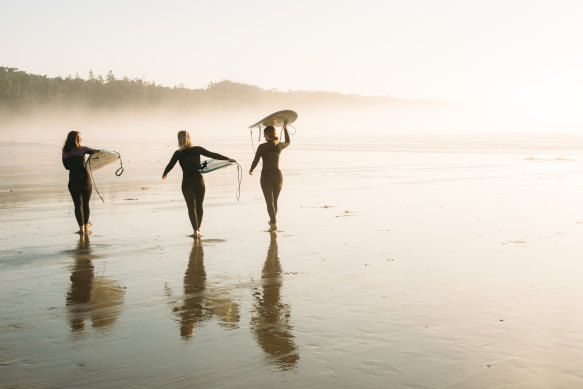
Surf’s up at Tofino, nicknamed Canada’s surf capital.Credit: Destination BC/Cristina Gareau
Since 1988, when the first surf event was organised on its storm-pounded beach, the village of Tofino has been known as the “Surf Capital of Canada”, attracting champions from the Cold Water Classic circuit as well as regular surf enthusiasts keen to take on the challenging but consistent waves and insanely cold water temperatures.
But as I listen to my instructor Ashtyn, from Tofino’s female-led Surf Sister surf school, advise on how best to paddle and pop up to ride the waves, my thoughts are more on surviving hyperthermia than style. But here goes nothing.
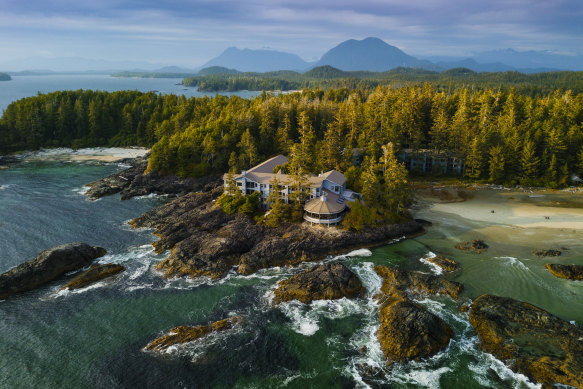
A post-surf hot shower is just a short walk away at the beautifully appointed Wickaninnish Inn
Carrying my board to the water’s edge, I’m relieved to discover the wetsuit booties I’m wearing are doing their job, with the extra-thick material resisting the cold as I inch my way in. In waist-deep white-water, Ash wastes no time in positioning me on the board, telling me to paddle furiously as a wave approaches. Within seconds, I’m rushing towards the shore, icy spray flicking in my eyes, too shocked to even attempt anything but cling to the board.
Ever-encouraging, Ash whoops and hollers as I emerge from the shallows, breathless, alive and grinning. She high-fives me for my bravery, before positioning me again for another incoming breaker: another fail in the pop-up stakes, but a clear win for the integrity of the wetsuit.
Kelly Slater I’ll never be, and having faced my fear and given this surfing lark a shot, I’m happy to leave the ocean to more elegant, younger and fitter board-riders. Fortunately, a hot shower is just steps away, a short walk along moody Chesterman Beach leading to the Wickaninnish Inn, an iconic luxury hotel perched on a rocky headland jutting into the Pacific.
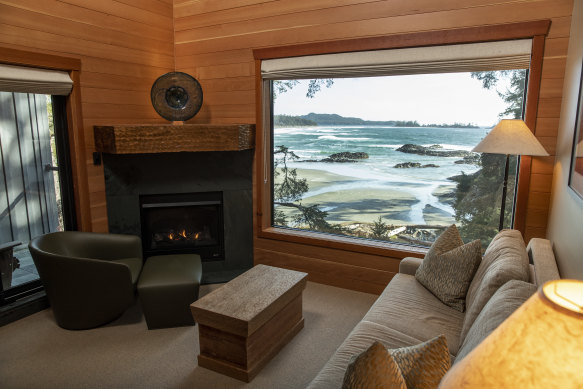
The Relais & Chateaux property juts right onto the Pacific Ocean.
Built by the local McDiarmid family, and under the management of innkeeper Charles McDiarmid since it opened in 1996, the Wick Inn (as it’s lovingly referred to) was largely responsible for transforming Tofino from a sleepy surf haven to a major tourist destination, luring cashed-up travellers through its Relais & Chateaux-endorsed doors to enjoy “rustic elegance on nature’s edge”.
Here, the environment is front and centre, with floor-to-ceiling windows framing ocean-liner views of the Pacific Ocean.
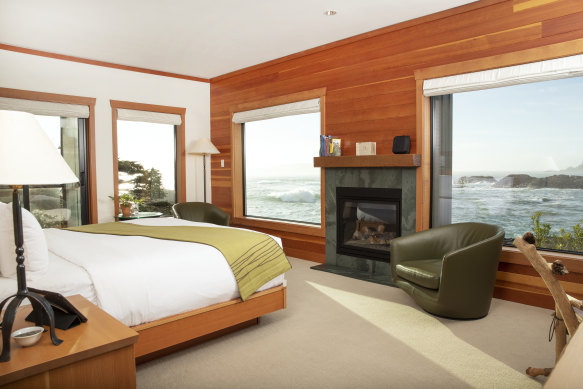
Furnishings made from upcycled driftwood bring the outdoors in.
My balcony door opens to the boom of a blowhole, the swell surging onto jagged black rocks mere metres away; while every tactile surface, from furniture made of driftwood to hand-adzed wooden door frames, represents Tofino’s unique location between the rainforest and the sea.
In the award-winning restaurant, The Pointe, microphones positioned under the eaves bring the sound of the ocean indoors; while rainwear and gumboots provided for guests are testament to the adage “there’s no such thing as bad weather, just poor clothing choices”.
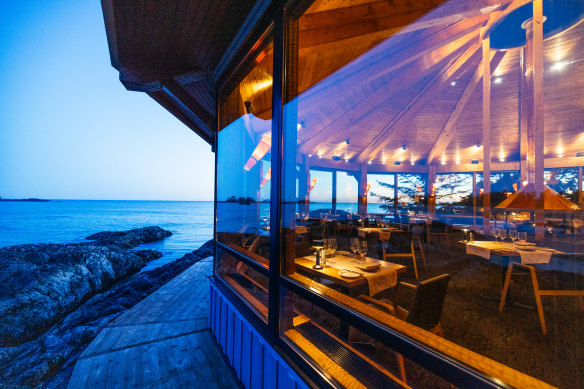
Pointe restaurant … microphones positioned under the eaves bring ocean sounds indoors.
In fact, the more furious the weather conditions in the wild, wild west, the better – at the Wickaninnish Inn, storm watching has become a “thing”, with the gale force winds and giant waves of winter luring a clientele who embrace Mother Nature’s fury, whether from the eye of the storm itself or in front of the fireplace in their guest room.
Conditions are a little calmer, however, on Clayoquot Sound, a UNESCO Biosphere Reserve separated from the fury of the Pacific by the strip of land where the township of Tofino nestles. Dotted with islands swathed with old-growth forests where wolves, black bears and bald eagles dominate, this is the traditional, unceded homeland for three First Nations Nuu-chah-nulth people – the Hesquiaht, the Ahousaht and the Tla-o-qui-aht.
As the original stewards of this rich and beautiful environment, the Ahousaht Nation now share their knowledge with visitors on Ahous Adventures boat trips through the sound, where a host of affable marine mammals find sanctuary. Humpbacks and around 200 resident grey whales are always good for a show; while orcas are a more elusive prize for cetacean lovers. Meanwhile, Californian sea lions have taken over abandoned salmon farms (which are being phased out in British Columbia by 2025 for environmental reasons); while families of adorable sea otters, floating on their backs in formations known as “rafts”, drift by on the current.
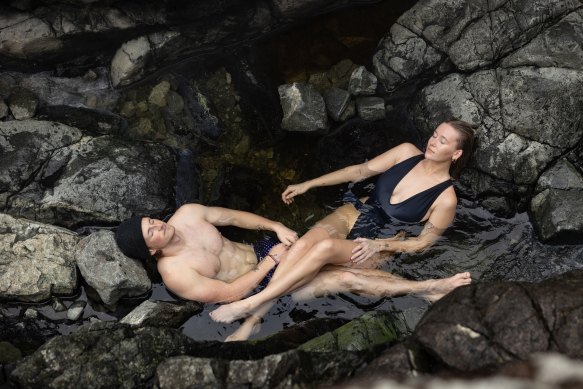
Seven pools of successively warm temperatures to thaw out in at Hot Springs Cove.
Our destination on this eco-tour is Hot Springs Cove, where a 1.5 kilometre boardwalk through the temperate rainforest leads to hot natural springs, used for centuries by Ahousaht people for medicinal and spiritual reasons. There are seven pools of successively warm temperatures to thaw out in, while a steaming waterfall provides the ultimate outdoor shower.
Back in Tofino, the bounty of the region is celebrated in an impressive array of restaurants, from casual joints such as The Shed that reflect the surf culture, to the fine dining of Shelter and the Wickaninnish Inn’s The Pointe.
Sustainability and mindfulness of the environment is at the heart of every menu, with chefs collaborating through the Tofino Ucluelet Culinary Guild, a community-driven collective that nurtures partnerships with growers to ensure fresh, affordable locally sourced ingredients.
Meanwhile, 30-minutes’ drive south of Tofino, the little town of Ucluelet punches well above its weight in the culinary stakes, with Pluvio – run by former Wick Inn chefs Warren Barr and Lily Verney-Downey – awarded Canada’s Best Destination Restaurant in 2022.
Playful nods to the environment abound, from the very name (a Pluviophile is someone who finds joy in the rain), to moss and rock table decorations; while the quirky use of ingredients, such as fermented unripe blueberries to complement wild-caught salmon (in a similar way to capers) is a touch of brilliance on its tasting menu.
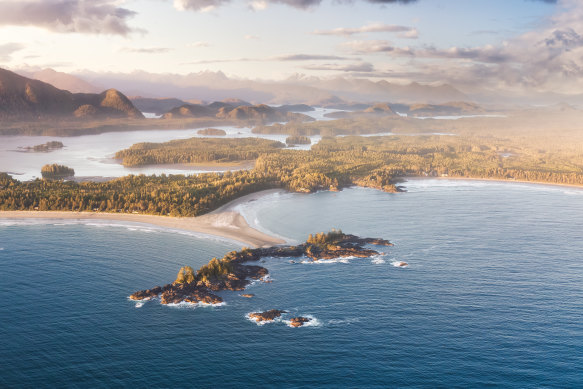
The island from above.Credit: iStock
One hundred kilometres in width and stretching for 456 kilometres from the British Columbia capital of Victoria to the northern wilds of Cape Scott, Vancouver Island is the largest island on the west coast of North America, cut by the jagged Vancouver Island Ranges that soar to 2195 metres.
Drier and more arable, the east coast of the island is as tranquil as the west is wild and woolly, with Vancouverites drawn to its mild climate, vineyards, beach lifestyle and spa resorts such as Comox Valley’s hydropathic Kingfisher Pacific Resort and Spa. Just half an hour inland, however, you can be skiing, snow-shoeing, hiking or mountain biking at Mount Washington, the island’s only full-service ski resort that receives some of the best snowfalls in North America with an annual average of over 11 metres.
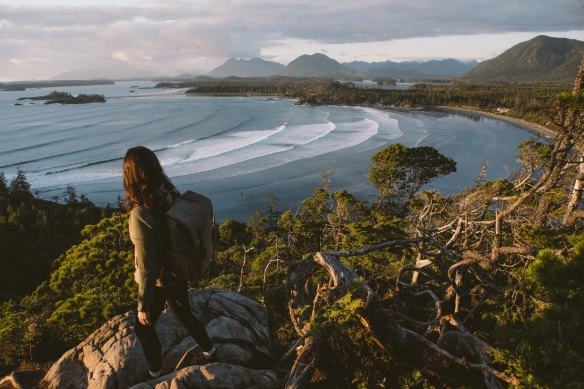
Vancouver Island attracts keen hikers and adventure seekers.
To explore this snowy wonderland, and to put the island into a visual perspective with the mainland, I’m taking to the sky with 49 North Helicopters, who run scenic flights as well as heli-skiing and fishing adventures on the island and the mainland.
On a 90-minute West Coast Glacier tour, we soar over the remote inlets that separate Vancouver Island from mainland BC and buzz along glaciers that cut the Coast Mountain Range, before landing on an isolated peak for the ultimate 360-degree view of this dramatic, wild landscape.
Before us lies Vancouver Island, its snowy peaks plummeting into shimmering fjords carved by ancient glaciers, dotted with a labyrinth of islands cloaked in dense forest. This is nature at its most unadulterated, and it’s impossible not to feel humbled – not only by its beauty and grandeur, but by the minimal human footprint, such an insignificant feature in this beautiful green and blue jigsaw puzzle.
The details
Stay
Wickaninnish Inn rooms from $C540 ($604) a night. See wickinn.com
At Kingfisher Resort & Spa at Comox, rooms cost from $C240 a night. See kingfisherresort.ca
Do
Surf Sister Surf School. See surfsister.com
Ahous Adventures. See ahousadventures.com
49 North Helicopters. See 49northhelicopters.com
Fly + ferry
Air Canada flies direct from Sydney and Melbourne to Vancouver daily. From Vancouver, catch the Hullo passenger ferry to Nanaimo on Vancouver Island or a car ferry from Vancouver’s Horseshoe Bay to Departure Bay. See aircanada.com; hullo.com; bcferries.com
The writer travelled as a guest of Destination Canada and Destination BC. See destinationcanada.com; hellobc.com
Sign up for the Traveller Deals newsletter
Get exclusive travel deals delivered straight to your inbox. Sign up now.